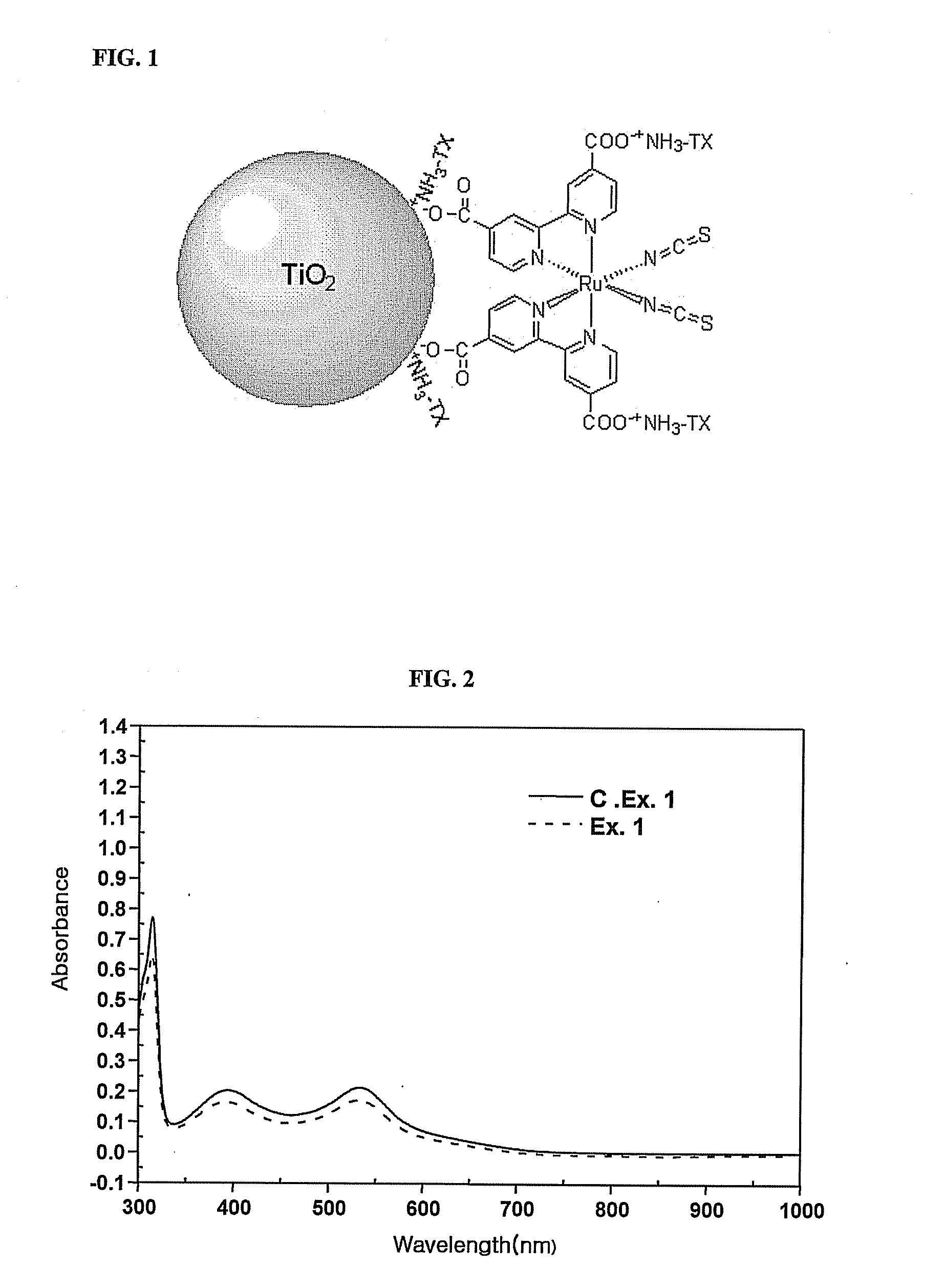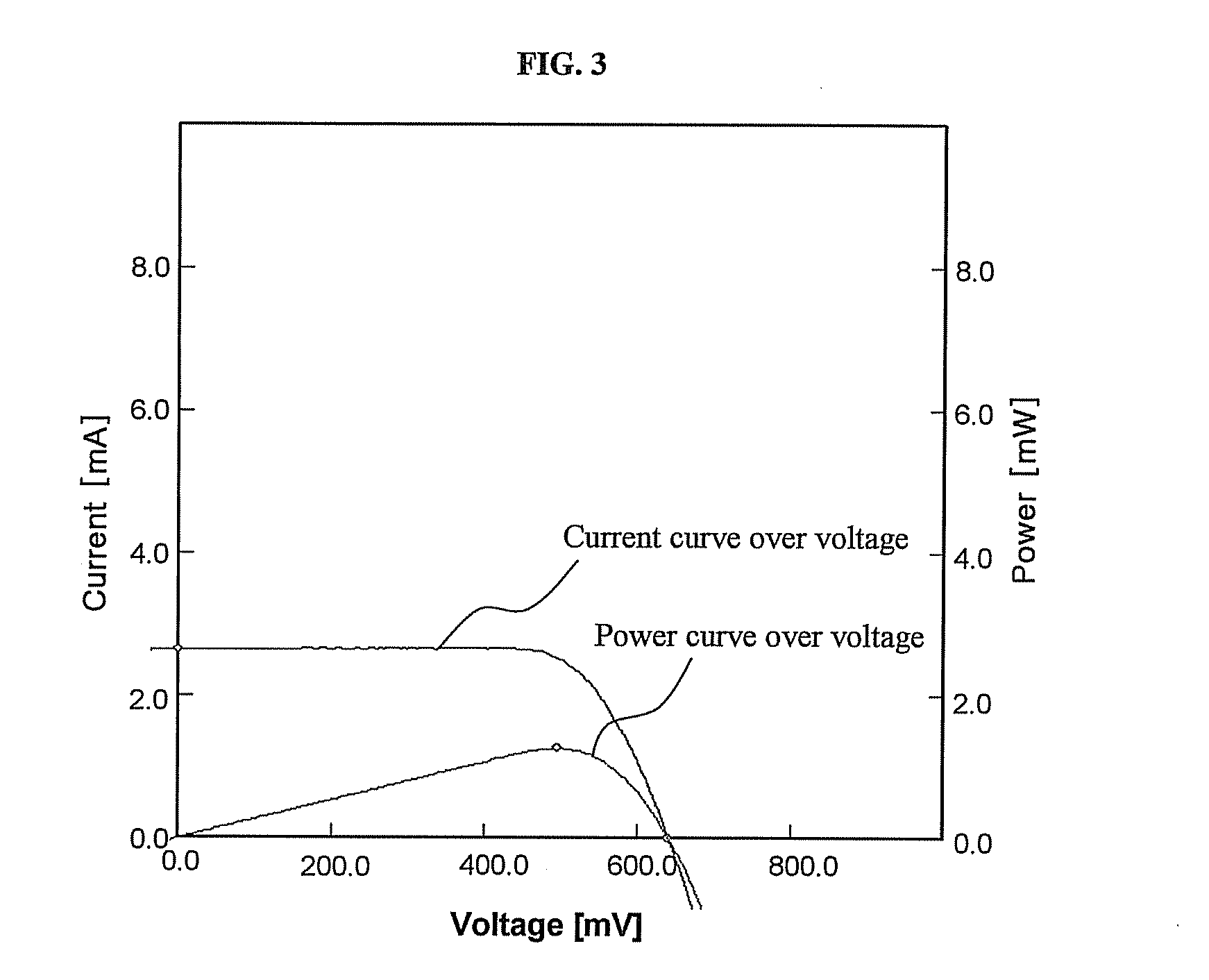Dye having dispersant function and solar cell comprising the same
a technology of solar cells and dyes, which is applied in the direction of organic chemistry, electrolytic capacitors, ruthenium organic compounds, etc., can solve the problems of reducing the uniformity and density of metal oxide films, difficult to use the entire surface area of metal oxide particles, and small amount of dyes adsorption relative to the optical cross-section of light, etc., to achieve good adsorption performance and increase the dispersibility and uniformity of paste compositions
- Summary
- Abstract
- Description
- Claims
- Application Information
AI Technical Summary
Benefits of technology
Problems solved by technology
Method used
Image
Examples
synthesis example
Synthesis of Dye of the Present Invention
[0074]
(1) Synthesis of Triton X-100-Mesylate
[0075]10 g (16 mmol) of Triton®X-100, available from Aldrich, was dissolved in anhydrous methylene chloride (20 ml). The solution was added with 4.86 g (48 mmol) of triethylamine, available from Aldrich, and then stirred in a nitrogen atmosphere for 10 min.
[0076]The reactor was placed into an ice bath, after which the reaction was conducted for 1 hour while 5.5 g (48 mmol) of methanesulfonyl chloride, available from Aldrich, was added slowly. Subsequently, the temperature was gradually increased to room temperature, while the reactants were stirred for 3 hours.
[0077]After the completion of the reaction, the reaction product was poured on ice water to separate an organic layer, which was then washed with a brine solution. The methylene chloride solution thus obtained was evaporated using a rotary evaporator to remove the solvent, and then the obtained viscous liquid was dried in a vacuum oven, yieldi...
example 1
Manufacture of Conductor Electrode and Solar Cell (1)
(1) Manufacture of Semiconductor Electrode
[0084]On a plastic substrate, fluorine-doped tin oxide (FTO) was applied by sputtering. Then, the paste composition obtained in the preparative example was applied using a screen printing process and burned at 120° C. for 1 hour, thus forming a light absorbing layer about 20 μm thick, thereby completing the semiconductor electrode of the present invention.
(2) Manufacture of Solar Cell
[0085]On the surface of a conductive transparent plastic substrate coated with ITO, platinum was applied, thus forming a counter electrode. Subsequently, the counter electrode, acting as an anode, and the semiconductor electrode obtained in (1), acting as a cathode, were assembled. When the two electrodes were assembled, the conductive surfaces of the anode and the cathode were disposed to face each other in the cell. This arrangement permitted the platinum layer and the light absorbing layer to face each othe...
example 2
Manufacture of Conductor Electrode and Solar Cell (2)
[0087]A dye-sensitized solar cell was manufactured in the same manner as in Example 1, with the exception that a layer of TiO2 17.720 μm thick was used as the metal oxide layer.
PUM
| Property | Measurement | Unit |
|---|---|---|
| temperature | aaaaa | aaaaa |
| temperature | aaaaa | aaaaa |
| temperature | aaaaa | aaaaa |
Abstract
Description
Claims
Application Information
 Login to View More
Login to View More - R&D
- Intellectual Property
- Life Sciences
- Materials
- Tech Scout
- Unparalleled Data Quality
- Higher Quality Content
- 60% Fewer Hallucinations
Browse by: Latest US Patents, China's latest patents, Technical Efficacy Thesaurus, Application Domain, Technology Topic, Popular Technical Reports.
© 2025 PatSnap. All rights reserved.Legal|Privacy policy|Modern Slavery Act Transparency Statement|Sitemap|About US| Contact US: help@patsnap.com



